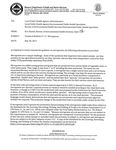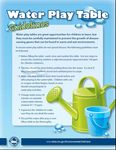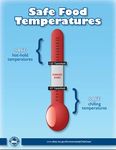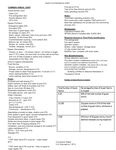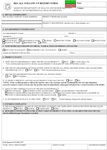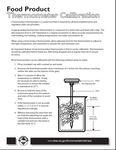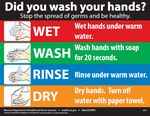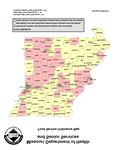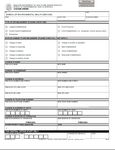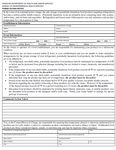EHOG APPENDIX - MISSOURI DEPARTMENT OF HEALTH AND SENIOR SERVICES Bureau of Environmental Health Services - Missouri Department of Health and ...
←
→
Page content transcription
If your browser does not render page correctly, please read the page content below
EHOG APPENDIX
Bureau of Environmental Health Services
MISSOURI DEPARTMENT OF HEALTH AND SENIOR SERVICESTable of Contents
1.0 Environmental Health Fundamentals
2.0 Food Safety
2.1 Recall Follow Up Report Form
2.2 Recall Follow Up Summary Report Form
2.3 Specialized Process Approval Application Flow Chart
2.4 Specialized Process Application Checklist
2.5 Chain of Custody Record of Specialized Process
2.6 HACCP Agreement
2.7 HACCP Resources
2.8 HACCP Plan Validation Checklist
2.9 HACCP Field Verification Checklist
2.10 3-502.12 Reduced Oxygen Packaging without a Special Process Approval, Criteria
2.11 Risk Control Plan
2.12 Work Order Process
2.13 Risk Based Inspection Assessment
2.14 How Businesses are Regulated for Food Safety
2.15 How Events are Regulated for Food Safety
2.16 Food Code Inspection Reference
2.17 Food Service Ordinance Map
2.18 TB F1-20 Food Code Manual Corrections
2.19 TB RFP21-03 Tetrahydrocannabinol (THC) in Food Products
2.20 TB F1-17 Microgreens
3.0 Lodging, Safety and Sanitation
3.1 Violation Notice
3.2 Inspection Reference Sheet
3.3 Change Order
3.4 TB L1-17 Compliance with Local Ordinances
4.0 Emergency Response
4.1 Can Classifications
4.2 Can Classifications - image
4.3 Power Outage Notice
5.0 Onsite Wastewater Treatment
5.1 Onsite Wastewater Treatment System Application Process Form
5.2 Holding Tank Use Agreement
5.3 Certification of System w/o Onsite Inspection with Cover Letter
5.4 Status of Certification of System w/o Onsite Inspection with Cover Letter
5.5 Application is Incomplete Cover Letter
5.6 Status of Permitted System Cover Letter
5.7 Statement of Probable Cause
5.8 Notice of Violation – example wording
5.9 Photo Documentation
5.10 IR-S3-15: Innovative System Sizing Approval for Infiltrator Water Technologies, LLC,
Quick4 Plus EQ36 LP and Quick4 EQ36 Chamber Systems
5.11 IR-S2-15: Design Sizing for AES Wastewater Treatment Systems
5.12 IR-S2-12: Experimental Protocol for Quick4 EQ36, Quick4 Plus EQ36 LP, and Quick4 Plus
Standard LP chambers
5.13 IR-S3-12: Innovative System Approval for EZflow by Infiltrator
5.14 IR-S4-12: Experimental Protocol for the Aero-Stream Remediation system
5.15 IR-S1-08: Innovative System Protocol for Zoeller Fusion Model ZF-450
6.0 Environmental Child Care6.1 IR-CI-15: Guidance on Disinfectant Use in Child Care Facilities
6.2 Handwashing Handout
6.3 Safe Food Temperatures Handout
6.4 Water Play Handout
6.5 Thermometer Calibration USDA Handout
6.6 Final Cooking Temperatures Handout
6.7 Shigellosis
7.0 Drinking Water
7.1 Well Image 1
7.2 Spring Water Supply Image
7.3 Well Image 2
7.4 Pump on Drilled Well Image
8.0 General Environmental HealthSpecialized Process Application Checklist
On completion of collection and initial review this information shall be submitted to the appropriate
Local Public Health Agency or Department of Health and Senior Services District office. This form can
be found on the Department’s Food Safety Web Page.
Name ___________________________________________________________________
Address _________________________________________________________________
Telephone Number ________________________________________________________
Section 1 – Check which specific specialized process. Submit a separate application for each process.
□ Smoking food (for preservation)
□ Curing food
□ Food additives (for preservation or to alter a food to a non-*PHF)
□ Packaging food using Reduced Oxygen Packaging except as specified under 3-502.12**
□ Custom Animal Processing (under Missouri Department of Agriculture (MDA) regulation)
□ Other (per Regulatory Authority)
Section 2 – Proposal
□ Statement of proposal citing code reference
□ Statement why this proposal should be approved
Section 3 – Supporting documentation
□ Scientific studies or other applicable supporting documentation
□ Process authority analysis reports
□ Prerequisite programs
□ Maintenance logs
□ Cleaning schedules
□ Employee policy manuals
□ Applicable Standard Operating Procedures
□ Applicable Standard Sanitation Operating Procedures
□ Examples of applicable checklists or records for verification of prerequisite programs and
procedures
□ Documentation of training programs and procedures including examples of training logs
Section 4 – HACCP plan
□ Recipe
□ Flow Chart
□ Hazard Analysis
□ Critical Control Point plan
□ List of each Critical Control Point□ Statement of specific Critical Limit to be measured
□ Statement of method and frequency of for monitoring
□ Statement of who is responsible for monitoring and what records are to be kept
□ Statement of corrective actions for each critical limit when not met
□ Examples of applicable records used to document corrective actions taken
□ Examples of verification records
□ Other
_________________________________________________________________________
Section 5 – Additional information
□ Examples of labeling and lot identification systems with explanations
□ Layout of area to be used showing all equipment to be used for specialized process
□ Explanation of physical or scheduling barriers between this area and other parts of the operation
□ Information as needed on
□ Safe source of water supply
□ Approved waste disposal
□ Methods to prevent cross-contamination
□ Use, storage and labeling of toxics
□ Pest control program
□ List of job descriptions of personnel involved in the specialized process
□ Calibration and use records on equipment used for monitoring Critical Control Point
□ Other __________________________________________________________________
I hereby certify that the above information is correct. I have provided all relevant material to the best of
my ability. I understand until such time as this special process proposal is approved I must cease
operation of any specialized process activity. I understand that submitting this application in no way
guarantees that my application will be approved. I understand that if this application is approved it can
be rescinded immediately during any official inspection if there is evidence of non-compliance with the
approved process.
Applicant Signature: ______________________________________________Date: __________
Print Name and Position Title: _____________________________________________________
Meets requirments: YES NO (If NO See comment sheet)
LPHA/DHSS Representative Signature: ________________________________ Date: __________
Print Name and Position Title: ______________________________________________________
Submit the completed checklist and supporting documentation to your Local Public Health Agency
(http://health.mo.gov/living/lpha/lphas.php). Questions may be directed to DHSS at (573) 751-6095
your Local Public Health Agency.
*PHF – potentially hazardous food**3-502.12 – Reduced Oxygen Packaging may be conducted without having to obtain a “specialized process approval” from the Bureau when Clostridium botulinum and Listeria monocytogenes is identified as a microbiological hazard in the final packaged form and there are at least two barriers in place to control the growth and toxin formation of C. botulinum and L. monocytogenes. The facility must have an approved Hazard Analysis Critical Control Point (HACCP) plan and written proof that the barriers utilized are sufficient to prevent growth of the identified pathogens. This could include scientific documentation along with monitoring records, or independent laboratory analysis as needed. A separate checklist is available to assist in developing a HACCP plan in accordance with 3-502.12. United States Department of Agriculture: http://www.fsis.usda.gov/wps/portal/fsis/topics/regulatory- compliance/haccp/small-and-very-small-plant-outreach/guidebook-haccp-plans-generic-haccp-models/haccp-plans- guidebook Iowa State University Extension: http://www.extension.iastate.edu/foodsafety/HACCP Food and Drug Administration HACCP: http://www.fda.gov/food/guidanceregulation/retailfoodprotection/foodcode/ucm054471.htm Food and Drug Administration Food Safety: http://www.fda.gov/downloads/Food/GuidanceRegulation/HACCP/UCM077957.pdf National Food Service Management Institute http://sop.nfsmi.org/HACCPBasedSOPs.php Association of Food and Drug Officials: http://www.afdo.org/seafoodhaccp/ Food and Drug Administration Food Safety Management Manual: http://www.fda.gov/downloads/Food/FoodSafety/RetailFoodProtection/ManagingFoodSafetyHACCPPrinciples/Operators/U CM077957.pdf UC Davis HACCP: http://ucfoodsafety.ucdavis.edu/Food_Processing/HACCP_Information/ University of Nebraska – Lincoln - Meat Products: http://food.unl.edu/web/meatproducts/introduction-to-haccp-training University of Nebraska – Lincoln - Meat Products HACCP: http://food.unl.edu/web/meatproducts/haccpdocandlink University of Nebraska – Lincoln – Meat Products SSOP: http://food.unl.edu/web/meatproducts/haccpsop#ssop
Chain-of-Custody Record for Specialized Process Material
Processor or Firm Name: ________________________________________________________
Agent or Representative: ________________________________________________________
Address: _____________________________ City:_________________ Zip: _________
General Description of Materials Relinquished/Received
___________________________________________________________________________________
___________________________________________________________________________________
___________________________________________________________________________________
___________________________________________________________________________________
___________________________________________________________________________________
_____________________________________________________
Relinquished by Agency Received by Agency Date Time
www.health.mo.gov
Healthy Missourians for life.
The Missouri Department of Health and Senior Services will be the leader in promoting, protecting and partnering for health.
AN EQUAL OPPORTUNITY / AFFIRMATIVE ACTION EMPLOYER: Services provided on a nondiscriminatory basis.
HACCP ResourcesHACCP Agreement
This agreement is entered into on this day of 20 , between
(Health Authority) and
(Processor).
Health Authority and Processor Agree that:
• Health Authority has the obligation under Sections 196.010 through 196.120, to ensure the
safety of food products in the State of Missouri.
• Under Section 196.055, the health authority shall have free access at all reasonable hours to any
factory, warehouse, or establishment in which foods are manufactured, processed, packed, or
held for introduction into commerce, or to enter any vehicle being used to transport or hold
such foods, to determine if any of the provisions of sections 196.010 to 196.120 are being
violated; and to secure samples or specimens of any food.
• Under state regulation, 19 CSR 20-1.025 Processor is required to submit to the Health
Authority a Hazard Analysis Critical Control Points (HACCP) plans.
• Processor’s HACCP plan contains recipes and processes in which the Processor has a
proprietary interest.
• Section 610.021 (15), allows documents which relate to scientific and technological
innovations in which the owner has a proprietary interest to be a closed record.
• HACCP plans submitted to the Health Authority shall remain closed and not be released to any
other entity, except for the Department of Health and Senior Services, without approval of
Processor.
Processor Health Authority
(signature) (signature)
(print name) (print name)
(company name) (organization name)United States Department of Agriculture: http://www.fsis.usda.gov/wps/portal/fsis/topics/regulatory-compliance/haccp/small-and-very-small-plant- outreach/guidebook-haccp-plans-generic-haccp-models/haccp-plans-guidebook Iowa State University Extension: http://www.extension.iastate.edu/foodsafety/HACCP Food and Drug Administration HACCP: http://www.fda.gov/food/guidanceregulation/retailfoodprotection/foodcode/ucm054471.htm Food and Drug Administration Food Safety: http://www.fda.gov/downloads/Food/GuidanceRegulation/HACCP/UCM077957.pdf National Food Service Management Institute http://sop.nfsmi.org/HACCPBasedSOPs.php Association of Food and Drug Officials: http://www.afdo.org/seafoodhaccp/ Food and Drug Administration Food Safety Management Manual: http://www.fda.gov/downloads/Food/FoodSafety/RetailFoodProtection/ManagingFoodSafetyHACCPPrinciples/ Operators/UCM077957.pdf UC Davis HACCP: http://ucfoodsafety.ucdavis.edu/Food_Processing/HACCP_Information/ University of Nebraska – Lincoln - Meat Products: http://food.unl.edu/web/meatproducts/introduction-to- haccp-training University of Nebraska – Lincoln - Meat Products HACCP: http://food.unl.edu/web/meatproducts/haccpdocandlink University of Nebraska – Lincoln – Meat Products SSOP: http://food.unl.edu/web/meatproducts/haccpsop#ssop
HACCP Plan Validation Checklist
Principle # 1 of HACCP - Hazard Analysis and Flow Chart – Check box if information has been provided,
Provide notes on deficiencies on a separate page. The documents written to support Principle #1 of HACCP are
some of the most critical and demanding documents in the written plan.
Under Principle #1, the following need to be included in a logical order:
Y N N/A
Name of the food product and the special process for which the HACCP plan is being submitted.
Is a Special Process application included?
Is sufficient data provided to support the petition?
Detailed formulation and complete list of ingredients.
Packaging and food contact materials, if used. Show that all are approved for food use.
Facility layout and information on whether a dedicated workspace is provided to conduct the special
process.
A detailed flow chart showing the holding and preparation of the food product from receiving raw
ingredients through packaging and any subsequent distribution. Flow chart should include each specific step
and should include cooking, filling and specific temperatures, times, pH or other hurdles that are designed to
control food hazards.
Hazard analysis is provided.
Description of intended use of product (i.e. Institutional use/Highly Susceptible Population)
Copy of labeling – Check for any required warning concerning temperatures or shelf-life and disposal
of food.
Description of how the shelf-life will be determined.
Principle #2 of HACCP – Establish Critical Control Points
Does the submitted information provide:
A description of the pertinent hazards associated with this food and special process?
Critical control points on the flow chart that are designed to control hazards associated with the
food?
A description of how the CCP will control the pertinent hazards and specific reference information
source?
Principle #3 of HACCP – Establish Critical Limits
Does the plan:
Provide a CL for each CC?Verify that the critical limit is correct based on Food Code?
Provide information on how the CL is measured?
Provide information that demonstrates that this CL controls the identified hazard(s)?
Principle #4 of HACCP – Establish Monitoring Procedures
Does the plan:
List of items to be monitored? The list will vary somewhat depending upon the special process.
Provide forms or checklists used for monitoring each item?.
State who will monitor the item? When will it be monitored and how often?
Provide examples of items that might be monitored: sanitation, pH, aw, calibration of equipment,
temperatures, recipe (each batch), corrective actions, employee training, plan verification and review, HACCP
revisions - changes in the recipe or protocols, receiving, food disposal, other.
Indicate if monitoring is an OBSERVATION or a MEASUREMENT.
Show that the instrument calibrated?
Document employee training?
Indicate how will records for continuous monitoring be provided? (example: cook chill/drying
meat/fermenting).
Principle #5 of HACCP – Establish Corrective Actions
Does the plan:
Have specific corrective actions for each CCP when out of compliance?
Specify who will be responsible for the corrective action?
Specify how each occurrence will be documented?
Specify how food disposal will be done when necessary (SOP)?
Establish a monitoring plan when deviations are identified?
Principle #6 of HACCP – Establish Record Keeping Procedures
Does the plan:
Specify records to be kept and where they are kept?
Describe of how long will records be kept?
Provide a plan revision schedule?
Describe where SOP and SSOP records are?
Describe employee training records and monitoring records and where they are located?Principle #7 of HACCP – Establish Verification Procedures
Does the plan:
Establish WHO is responsible for verification?
Establish what the procedure for verification and the frequency is?
Establish what will be verified?
Establish that the verification will confirm that established procedures are followed?
Establish the verification will be documented in writing and any actions taken recorded?
Establish that the HACCP system is reviewed annually to keep information up-to-date?
Establish a policy that the HACCP team will send notification of significant changes in process or
HACCP plan to the regulatory authority?
Reviewed by: __________________________________________________________________________
Agency: ______________________________________________________________________________
Review Dates: _________________________________________________________________________
See additional pages for notes.HACCP Field Verification Checklist
Establishment Name:
Address:
Person-in-Charge: Phone: e-mail:
Date Written Plan Validated:
Food Product and Process:
Inspection Type:
☐ HACCP Plan Review
☐ Record Review
☐ On-Site Verification
Inspector:
YES NO Validated HACCP Plan Available for Review
Comments:
List Critical Control Points (CCPs) and Critical Limits identified by the establishment’s HACCP plan.
Food Item or Process Critical Control Point Critical Limits Comments/
e.g. receiving, cooler Problems Noted
storage, dry storage
What monitoring records are required by the establishment’s HACCP plan?
Type of Record Monitoring Frequency and Record Location
Procedure
(Where kept?)YES NO N/A Establishment has Implemented Effective SOP, SSOP, and Pre-Requisite
Programs. (Document issues or non-compliances in comments.)
Vendor certification programs and buyer specifications
Approved vendor documentation and product labeled for traceability
Dedicated work areas for raw and prepared foods
Food preparation complies with HACCP Plan
Hand washing and bare hand contact policies
Equipment specifications/Manufacturer’s instructions and operational manual.
Employee health policy (training and reporting requirements; exclusion and
restriction requirements for ill food employees)
Storage and display temperature 5°C (41°F)/ 3°C
Employee training
Employee hygiene policy (clean clothing; hair restraints; prohibition of eating,
smoking and drinking in work areas and of wearing jewelry)
Thermometer calibration procedures and schedule
Program to protect product from contamination--biological, chemical and physical
Cleaning and sanitizing procedures
Other
Comments
YES NO N/A Accurate Description of Product/Process and Intended Uses (Document issues or
non-compliances in comments.)
Food flow, menu, packaging and formulation are consistent with flow chart and
approved HACCP
Temperature and other critical control points and critical limits are followed per
HACCP plan
ROP products not requiring a variance are packaged as prescribed by the Food
Code Section 3.502.12Employee demonstrates calibration, temperature and CCP measurement for
inspector
Employee uses forms for recording recipe, calibration, temperature or other
measurement during inspection
An accurate description or list of products to be reduced oxygen packaged is
provided in the HACCP plan
Comments:
YES NO N/A Hazards (Document issues or non-compliances in comments.)
Establishment identifies individual(s) responsible for maintaining system and
verification that required records are being completed and properly maintained
Records for the present day are accurate for the observed situation in the facility
Employee demonstrates knowledge of CCPs and critical limits for their retail
process when asked
Employee demonstrates understanding of importance of critical limit(s) when
asked
Routine calibrations are performed, and documented on the appropriate form
according to the plan
Monitoring actions are performed according to the HACCP plan
Are there specific issues with the current monitoring or record keeping regime.
Comments:
YES NO Shows Knowledge (Document issues or non-compliances in comments.)
When critical limits established by the plan are not met, are immediate corrective actions
taken and recorded
Employee knows whom to contact to take corrective actions. Uses corrective action
monitoring form
Person-in-charge shows knowledge of corrective action and proper disposal of food unfit for
consumption
Corrective actions taken reflect the same actions described in the establishment’s plan
Comments:YES NO NA Training (Document issues or non-compliances in comments.)
The establishment has a training program to support the plan. If deficient, describe
in comments
When training is provided, is it documented and are the records available
Employee demonstrates calibration and pH, temperature or CCP measurement for
inspector
Comments:
YES NO Do managers and employees demonstrate knowledge of the plan?
Comments:
YES NO N/A Other issues or comments needing attention
Comments:
Corrective Action Needed
☐ No (Establishment is in compliance)
☐ Yes (Field Verification form, Sanitation Observation Form or Inspection Report Form attached)
☐ Suspension of HACCP operation
☐ Embargo of food
☐ Voluntary disposal of food
☐ Employee restriction/exclusion
☐ Employee training
☐ Other:____________________________________
Inspector: ___________________________ Date of Inspection: _________________________3-502.12 Reduced Oxygen Packaging without a Special Process Approval, Criteria
Except for an establishment that obtains a special process approval as specified under § 3-502.11 of the
Missouri Food Code, a food establishment that packages a potentially hazardous food (PHF) using a
reduced oxygen packaging (ROP) method shall control the growth and toxin formation of Clostridium
botulinum and the growth of Listeria monocytogenes.
A food establishment that packages a PHF using an ROP method such as vacuum packaging, modified
atmosphere packaging, cook/chill packaging or sous vide packaging shall implement a HACCP plan
that contains the information specified under ¶¶ 8-201.14 (B) and (D) of the Missouri Food Code and
that:
(1) identifies the food to be packaged: _________________________________________________
(2) requires that vacuum packaged food(s) shall be maintained at 5°C (41°F) or less and meet at least
one of the following criteria:
□ has an AW of 0.91 or less,
□ has a pH of 4.6 or less,
□ is a meat or poultry product cured at a food processing plant regulated by the USDA using
substances specified in 9 CFR 424.21, Use of food ingredients and sources of radiation, and is
received in an intact package, or
□ is a food with a high level of competing organisms such as raw meat, raw poultry, or raw
vegetables;
(3) describes how the package shall be prominently and conspicuously labeled on the principal display
panel in bold type on a contrasting background, with instructions to:
□ maintain the food at 41oF (5oC) or below, and
□ discard the food if within 30 calendar days of its packaging if it is not served for on-premises
consumption, or consumed if served or sold for off-premises consumption;
(4) limits the refrigerated shelf life to no more than 30 calendar days from packaging to consumption,
except the time the product is maintained frozen, or the original manufacturer’s “sell by” or “use by”
date, whichever occurs first;
(5) includes operational procedures that:
□ prohibit contacting ready-to-eat food with bare hands as specified under ¶ 3-301.11(B) of the
Missouri Food Code,
□ identifies a designated work area and the method by which:
• physical barriers or methods of separation of raw foods and ready-to-eat foods minimize
cross contamination, and
• access to the processing equipment is limited to responsible trained personnel familiar with
the potential hazards of the operation, and
□ delineates cleaning and sanitization procedures for food-contact surfaces; and
(6) describes the training program that ensures that the individual responsible for the ROP operation
understands the:
□ concepts required for a safe operation,
□ equipment and facilities, and
□ procedures specified under the previous section and ¶¶ 8-201.14 (B) and (D) of the Missouri
Food Code.
(7) is provided to the regulatory authority prior to implementationA food establishment may not package fish using an ROP method unless the fish is frozen before,
during, and after packaging.
A food establishment that packages PHF using a cook-chill or sous vide process shall:
(1) provide to the regulatory authority prior a HACCP plan that contains the information as specified
under ¶¶ 8-201.14 (B) and (D) of the Missouri Food Code;
(2) the HACCP plan shall show how the establishment plans to ensure the food is:
a. prepared and consumed on the premises, or
b. prepared and consumed off the premises but within the same business entity with no distribution
or sale of the packaged product to another business entity or the consumer,
c. cooked to heat all parts of the food to a temperature and for a time as specified under ¶¶ 3-
401.11 (A), (B), and (C) of the Missouri Food Code,
d. protected from contamination before and after cooking as specified under Parts 3-3 and 3-4 of
the Missouri Food Code,
e. placed in a package with an oxygen barrier and sealed before cooking, or
f. placed in a package and sealed immediately after cooking and before reaching a temperature
below 57°C (135°F),
g. cooled to 5°C (41°F) in the sealed package or bag as specified under § 3-501.14 of the Missouri
Food Code and:
□ Cooled to 1°C (34°F) within 48 hours of reaching 5°C (41°F) and held at that temperature
until consumed or discarded within 30 days after the date of packaging; or
□ Held at 5°C (41°F) or less for no more than 7 days, at which time the food must be consumed
or discarded; or
□ Held frozen with no shelf life restriction while frozen until consumed or used
h. held in a refrigeration unit that is equipped with an electronic system that continuously monitors
time and temperature and is visually examined for proper operation at least twice daily, and
i. if transported off-site to a satellite location of the same business entity, equipped with verifiable
electronic monitoring devices to ensure that times and temperatures are monitored during
transportation, and
j. labeled with the product name and the date packaged; and
(3) include a plan to maintain the records required to confirm that cooling and cold holding refrigeration
time/temperature parameters are required as part of the HACCP plan and:
a. Make such records available to the regulatory authority upon request, and
b. Hold such records for at least 6 months; and
(4) implement written operational procedures and a training program.
A food establishment that packages cheese using a ROP method shall:
(1) limit the cheeses packaged to those that are commercially manufactured in a food processing plant
with no ingredients added in the food establishment and that meet the Standards of Identity as
specified in 21 CFR 133.150 Hard cheeses, 21 CFR 133.169 Pasteurized process cheese or 21 CFR
133.187 Semisoft cheeses; and
(2) have a HACCP plan that contains the information specified under ¶¶ 8-201.14 (B) and (D) of the
Missouri Food Code; and
(3) labels the package on the principal display panel with a “use by” date that does not exceed 30 days
from its packaging or the original manufacturer’s “sell by” or “use by” date, whichever occurs first;
and(4) Discards the ROP cheese if it is not sold for off-premises consumption or consumed within 30
calendar days of its packaging.
A HACCP plan is not required when a food establishment uses a ROP method to a PHF that is always:
(1) labeled with the production time and date, and
(2) held at 5°C (41°F) or less during refrigerated storage, and
(3) removed from its package in the food establishment within 48 hours after packaging.
I hereby certify that the above information is correct. I have provided all relevant material to the best of
my ability. I understand that submitting this application in no way guarantees that my application will
be approved. I understand that if this application is approved it can be rescinded immediately during
any official inspection if there is evidence of non-compliance with the approved process.
Applicant Signature: ___________________________________________Date: _____________
Print Name and Position Title: _____________________________________________________
Establishment Name and City: _____________________________________________________
Approved: YES NO (If NO See comment sheet)
DHSS Representative Signature:_________________________________ Date: ______________
Print Name and Position Title: _____________________________________________________RISK CONTROL PLAN
Establishment Type of
Name: Facility:
Physical County:
Address:
Person in Title:
Charge:
Inspector: Agency:
The “risk control plan” is a voluntary agreement between the operator of the food establishment and the
regulatory authority. It is intended to help management regain control over a hazard which was out of
control at the time of the inspection. Based on the recent inspection the uncontrolled hazard noted
below was identified. A separate risk control plan will be completed for other identified hazards. The
inspection report identifies the uncontrolled hazards that may contribute to foodborne illnesses. The risk
factors and public health interventions are described in the Food Code.
UNCONTROLLED CODE REQUIREMENT DESCRIPTION OF CORRECTIVE ACTION
HAZARD (RISK ACTION TO WHEN LIMITS ARE NOT
FACTOR) ESTABLISH CONTROL MET
OVER HAZARDThe provisions of this voluntary “risk control plan have been reviewed and are understood ____________________________ _____________________ (Operator) (date) ____________________________ _____________________ (Inspector) (date) Inspection frequency will increase to assure that the facility implements corrective measures. Facility representative declines to implement the risk control plan.
Routine Inspection
Conducted by LPHA
Inspection/Work Order Process
Approved
Yes No
Inspection
Conduct Future Inspections Conduct Follow-up Inspections per
per Frequency/Schedule in Return Date Set on Initial Inspection
Written Plan
Yes Approved
Inspection
No
No
Evaluate the
Is a Follow- Severity of the
up Violations.*
Yes No
Inspection
Is Enforcement
Needed?
Needed?
Conduct another
Follow-up Inspection*
Yes
Approved
No
Inspection
Consult with Regional
EPHS. Schedule a
Follow-up Inspection
Yes
EPHS IV & V Consult
with Program Manager
Yes
* Follow-up Inspections may
Approved No Issue Work Order.
continue for a period of time
Inspection (Continue Process on
dependent upon both the nature of No
Closing Order Flow
the violations and approval of the
Chart)
EPHS V and Program Manager.Work Order Issued. Regional EPHS V
consults with Program Manager
Program Manager consults with
BEHS Chief. Closing Order is
prepared and faxed to EPHS V.
LPHA EPHS and BEHS EPHS
conduct Follow-up Inspection on
Return Date set in Work Order
Conduct Future
Inspections at an Approved
Accelerated Frequency Yes
Inspection
as established in
Written Plan
BEHS Notifies
No Legislative Liaison
Closing Order Served EPHS V Notifies BEHS
LPHA Verifies that
Establishment Remains Closed
Upon Request of Establishment, LPHA and
BEHS EPHS Conduct Follow-up Inspection
No
Violations
Noted on Facility Remains Closed
Work Order
Yes
Regional EPHS V Contacts Program
Manager/Bureau Chief. Establishment Re-opens.
BEHS Notifies Legislative LiaisonRisk Based Inspection Assessment Establishment Name: _______________________________________ Owner: _________________________________ Establishment Address: _______________________________________________________________________________ Check all that apply. If a facility meets one or more criteria in any category it must be classified at the higher risk/priority. High Priority (examples include full service restaurants, nursing homes, and hospitals) Extensive menu. Potentially hazardous and non-potentially hazardous foods held and prepared. Extensive handling of raw ingredients. Complex preparation including cooking, cooling, and reheating; Potentially hazardous foods are prepared (hot or cold) and held hot or cold. Highly susceptible population served (nursing home, hospital, senior center and child care). Conducts a specialized process: smoking, curing, reduced oxygen packaging, etc. >400 patrons/meals served per day. Medium Priority (examples include grocery stores, schools, and fast food restaurants) Potentially hazardous foods require minimal assembly, and are cooked and served immediately. Potentially hazardous foods may be held for hot or cold holding after preparation or cooking. Complex preparation is limited to only a few potentially hazardous foods that require cooking, cooling, and reheating. Establishments that would otherwise be assessed as High Priority, but have shown through inspection history to have achieved active managerial control of foodborne illness risk factors. New establishments that would be assessed as Low Priority but because of a lack of inspection history demonstrating active managerial control of foodborne illness risk factors.
Table 1: How Businesses are Regulated for Food Safety
The vendor operates a storefront, warehouse, processing plant, mobile cart, or mobile truck/trailer and provides food for:
Consumers (retail) Businesses (wholesale) Consumers AND
Businesses
Does the vendor produce their own baked good, Vendors that provide food or food Vendors that provide
jam, jelly, dried herb, or herb mix? ingredients to other businesses are regulated food products to both
by state/federal agencies according to the consumers and
type of product. See below. businesses are most
Yes No Products containing Meat Products that contain likely to be regulated and
Cottage food is exempt from Does the vendor produce No Meat inspected as both a
inspection under state law as other non potentially USDA and the MO Dept. of
long as the following are hazardous foods only, such as Agriculture regulate the Milk: manufacturing
retailer and wholesaler.
met: fruit butters, sorghum, cracked wholesaling of poultry grade milk and See accompanying
1. Products are not nuts, dry products and red meat manufacturing sections regarding
determined to be potentially cookie/cake/bread/soup such as beef and pork. grade milk producers are retailers and wholesalers.
hazardous by the MO Dept. mixes, honey or other raw Most products that contain inspected by the MO
Note the only wholesaled
of Health. agricultural commodity? greater than 3% raw meat; State Milk Board.
2. Annual gross sales are Yes No 2% or more cooked meat commodities exempt
$50,000 or less. Vendor is Vendor is a are subject to inspection Eggs: producers may be from inspection are…
3. Products are sold directly exempt from food by the USDA and/or the inspected by various
to consumers. No internet routine establishment MO Dept. of Agriculture. entities depending how
sales. inspection as subject to We recommend vendors the eggs are used. An
4. Products are labeled with long as the inspection that wholesale these egg license may be
the name and address of the following are under the products contact the MO required by the MO
operation and a statement met: Missouri Dept. of Agriculture first Dept. of Agriculture.
that the food is not inspected 1. Local Food Code. for guidance.
by the state or local food ordinances Contact the Drugs/Dietary
establishment. allow it. Local Public U.S. FDA is responsible for Supplements: Drugs and
2. Products are Health all non-specified red meats Dietary Supplements are
sold directly to Agency. (bison, rabbits, game inspected by the U.S.
the consumer. Certain animals, zoo animals and FDA.
No internet exemptions all members of the deer
sales. to exclusively family including elk Raw Agricultural
3. Products private (wapiti) and moose)). FDA Commodities: Defined in
meet certain events and is responsible for all non- federal law. Limited
labeling nonprofit specified birds including regulation by the U.S.
requirements. fundraisers wild turkeys, wild ducks, FDA and DHSS until they
4. Products are may apply. and wild geese. are processed.
not identified
as being U.S. FDA is responsible for Other Commodities:
adulterated, most fish/seafood. USDA Other food products are
misbranded, or is responsible for the inspected by the U.S.
associated regulation of catfish. FDA and DHSS. The
with majority of businesses
foodborne Exemption: Vendors who who engage in
illness. process fewer than 1,000 wholesaling foods in
chickens and/or rabbits are Missouri fall into this
generally exempt from category.
inspection.
Caterers are subject to
inspection under the
Missouri Food Code.
For event-based delivery of food products, see Table 2.Table 2: How Events are Regulated for Food Safety
The Event is a Private Function, Charitable Fundraising Event, Nonprofit Service, or Individual Stand:
Individual Stands Private Functions Charitable Fundraising Nonprofit Service
In general, individual Private events that do not Missouri Law (196.056) Nonprofit organizations
stands that provide food provide food to the public do allows nonprofit that regularly offer
to the public are not meet the definition of a organizations to prepare foodservice to the public
considered food food establishment and are food in uninspected kitchens in a format similar to for-
establishments and are exempt from inspection under for distribution to end profit permanent vendors
subject to inspection the Missouri food code. consumers at charitable fall within the definition of
under the Missouri food fundraising events. As such, a food establishment and
code. A roadside kettle Key indicators of a private charitable fundraising events are subject to routine
corn stand and a corn function include: are generally exempt from inspection under the food
dog stand at a county • NOT open to the public. inspection. code. Senior centers,
fair are two common • Normally held to soup kitchens, and food
examples. However, commemorate or mark an This exemption does not pantries are a few
Missouri laws/rules occasion. apply in Boone, Jackson, examples.
generally exempt the • Examples include but are Jefferson, St. Charles, and St.
following types of stands not limited to church Louis Counties, and St. Louis Nonprofit organizations
from inspection: potlucks, wedding City and Kansas City. that provide event-style
receptions, funeral intermittent foodservice
• A stand that offers receptions, birthday may qualify for the
only prepackaged parties, anniversary charitable fundraising
foods that are not parties, company get- exemption depending on
potentially togethers, and political the specifics of a given
hazardous. gatherings. situation. These
• A produce stand operations should be
that offers whole, NOTE: caterers operating from evaluated by local health
uncut fruits and food establishments and departments and its
vegetables. providing food to the private partners on a case-by-case
• Cottage food stands. function are not exempt sole basis.
• Stands operated by due to their association with
nonprofit the private function.
organizations as a
fundraising event.MEMO
TECHNICAL BULLETIN NUMBER RFP21-03
TO: DHSS BEHS and LPHA Inspection Staff
EH
THROUGH: Eric Hueste, Chief, Bureau of Environmental Health Services
THROUGH: Dusty Johnson, Assistant Chief, Bureau of Environmental Health Services
FROM: Nancy Beyer, Retail Food Program Manager
SUBJECT: Tetrahydrocannabinol (THC) in Food Products
ISSUE DATE: April 1, 2021
EFFECTIVE DATE: Immediate
CONTACT: Nancy Beyer, Program Manager
nancy.beyer@health.mo.gov
(573) 751-6095
The Department of Health and Senior Services’ (DHSS) retail food program recently received several
inquiries regarding the addition of varieties of tetrahydrocannabinol (THC) into food products. This
technical bulletin is intended to share DHSS’ current thinking on this subject. Technical Bulletins do
not create or confer any rights for or on any person and do not operate to bind DHSS, Local Public
Health Agencies, or the public. Alternative approaches may be possible if the approach satisfies the
requirements of the applicable statutes and regulations.
According to the U.S. Drug Enforcement Agency, marijuana is a mind-altering (psychoactive) drug,
produced by the Cannabis sativa plant. Marijuana contains over 480 constituents and THC-9 (delta-9-
tetrahydrocannabinol) is believed to be the main ingredient that produces the psychoactive effect.1
Yet another constituent of marijuana is Delta-8-THC or THC-8 (delta-8- tetrahydrocannabinol). THC-8
is less potent and not as well-known but appears to be gaining recognition. Some individuals believe
that THC-8 was exempted from the Controlled Substances Act in the 2018 federal farm bill. This idea
is explained in a recent Rolling Stone article: https://www.rollingstone.com/culture/culture-
features/delta-8-thc-legal-weed- explained-1113859/.
www.health.mo.gov
Healthy Missourians for life.
The Missouri Department of Health and Senior Services will be the leader in promoting, protecting and partnering for Health.
AN EQUAL OPPORTUNITY / AFFIRMATIVE ACTION EMPLOYER: Services provided on a nondiscriminatory basis.The U.S. Food and Drug Administration’s stance on cannabis and cannabis-derived products is
posted online at https://www.fda.gov/news-events/public-health-focus/fda-regulation- cannabis-
and-cannabis-derived-products-including-cannabidiol-cbd. FDA’s stance is summarized in the
response reproduced below from Question 2 of their Q and A section:
The 2018 Farm Bill, however, explicitly preserved FDA’s authority to regulate products
containing cannabis or cannabis-derived compounds under the FD&C Act and section 351 of
the Public Health Service Act (PHS Act). FDA treats products containing cannabis or
cannabis-derived compounds as it does any other FDA-regulated products — meaning
they’re subject to the same authorities and requirements as FDA-regulated products
containing any other substance. This is true regardless of whether the cannabis or cannabis-
derived compounds are classified as hemp under the 2018 Farm Bill.
In Question 10, FDA goes on to state that that it is not legal under federal law to add THC to a
food product.
The ongoing conflicts with federal and state regulations as well as enthusiasm from cannabis
advocates has created a difficult and confusing regulatory environment. However, the following
Missouri laws and rules do not support the addition of THC into food:
• 19 CSR 20-1.025 3-101.11 Food shall be safe, unadulterated, and, as specified under 3-
601.12, honestly presented. Food additives must typically be recognized by U.S. FDA as safe
and preapproved to be included in food. This is not the case with THC.
• 19 CSR 20-1.025 3-201.11(A) Food shall be obtained from inspected and approved
sources that comply with law. There are no inspected or approved sources of THC
compounds in Missouri, except those licensed through the DHSS Section for Medical
Marijuana Regulation (Missouri legalized medical marijuana through an initiative
petition in November 2018).
• 19 CSR 20-1.025 3.202.12 Food may not contain unapproved food additives or additives that
exceed amounts specified in 21 CFR 170-180 relating to food additives… THC is not an FDA-
approved food additive.
• 196.010 RSMo defines food, drug, and new drug separately. They are consistently
addressed separately throughout Chapter 196 RSMo. This is consistent with the federal
FD&C Act, as state law is based on early versions of the federal law. In other words, an
article is usually regarded as a food or a drug, but not both.
Food products with THC-9 are regulated as drug products under state medical marijuana laws.
There are no permissive state laws for adding other forms of THC including THC-8 to foods.
Food companies that wish to add THC ingredients to their foods are subject to the relevant laws and
regulations that govern all food products, including those that relate to the food additive and GRAS
approval processes. Those wanting to pursue approval as a food ingredient should be referred to
FDA and its website for more information about these approval processes.
1
https://www.dea.gov/taxonomy/term/336
2Missouri Department of Health and Senior Services
P.O. Box 570, Jefferson City, MO 65102-0570 Phone: 573-751-6400 FAX: 573-751-6010
RELAY MISSOURI for Hearing and Speech Impaired 1-800-735-2966 VOICE 1-800-735-2466
Randall W. Williams, MD, FACOG Eric R. Greitens
Director Governor
TO: Local Public Health Agency Administrators
Local Public Health Agency Environmental Public Health Specialists
Bureau of Environmental Health Services Environmental Public Health Specialists
FROM: Eric Hueste, Bureau of Environmental Health Services, Chief
SUBJECT: Technical Bulletin L1-17 Compliance with Local Ordinances, (form E9.03)
DATE: April 14, 2017
Differences in how agencies were documenting compliance with the allowance in 315.019 RSMo, prompted the Bureau
of Environmental Health Services to develop a form to standardize what is submitted.
Section 315.019 RSMo, allows a local city or county ordinance to be used in place of the lodging rule; when that
ordinance is for one of the following areas:
• Fire safety,
• Installation and maintenance of electrical wiring,
• Venting of fuel-burning appliances,
• Installation and maintenance of plumbing, and
• Installation and maintenance of swimming pools and spas.
Since the lodging statute has a provision that would allow the facility to meet the local code and not the state’s code, a
method that could be used uniformly statewide was needed. For a local city or county ordinance to exempt a lodging
facility from the lodging rule, the agency must have jurisdiction, conduct inspections, and sign the Compliance with
Local Ordinances, (form E9.03).
The Compliance with Local Ordinances, (form E9.03) form will be completed annually during the lodging inspection. It
will be provided to the owner or manager. Inspectors need to be familiar with what local ordinances may apply to
lodging establishments and complete the E9.03 form accordingly. It is the owner or manager of the lodging
establishment who is responsible for pursuing the allowance; not the inspector. When conducting the inspection the
inspector should document all observed violations. When it is necessary to complete the E9.03 form, only those
violations in the five categories listed previously will need to be recorded. The E9.03 form would need to be completed
for violations noted in these sections of the inspection form: D4 and D7; all of E, F, and G; and H1 and H4. In order for
the local code to be used in lieu of the lodging rule, the local city or county agency, with jurisdiction for the areas noted
in 315.019 RSMo, must sign the E9.03 form. If that agency doesn’t sign the form, the lodging establishment must
address the violations and comply with the lodging rule. An “approved” lodging inspection cannot be issued until all
violations are corrected.
When a local city or county exempts an establishment from a portion of the lodging rule, the inspector should note this
on the comment page of the inspection form. For example: “City fire department signed E9.03 form on 12/30/16,
stating that smoke detectors do not need to be hard-wired with battery back-up.” The original signed E9.03 form should
be retained in the lodging establishment file. For questions or concerns please contact Ellen Dettman, the Retail Food
and Program Manager at 573-751-6095.
www.health.mo.gov
Healthy Missourians for life.
The Missouri Department of Health and Senior Services will be the leader in promoting, protecting and partnering for health.
AN EQUAL OPPORTUNITY / AFFIRMATIVE ACTION EMPLOYER: Services provided on a nondiscriminatory basis.Can Classifications 1. FLAT – A can with both ends concave; the can remains in this condition even when the can is brought down sharply on its end on a solid flat surface. 2. FLIPPER – A can that normally appears flat, but when brought down sharply on its end on a flat surface; one end flips out. When pressure is applied to this end, it flips in again and can appear flat. 3. SPRINGER – A can with one end permanently bulged. When sufficient pressure is applied to this end, it will flip in, but the other end will flip out. 4. SOFT SWELL – A can bulged at both ends but not so tightly, the ends cannot be pushed in somewhat with thumb pressure. 5. HARD SWELL – A can bulged so tightly at both ends that no indentation can be made with thumb pressure. A hard swell will generally “buckle” before the can bursts. Bursting usually occurs at the double seam over the side lap or in the middle of the seam.
Onsite Wastewater Treatment System Application Process Form
Application Number: ______________________ Date Application Sent: ________________
Owner’s Name: __________________________ Daytime Phone: ______________________
Mailing Address: _________________________ Evening Phone: ______________________
________________________ County: ____________________________
Property Address: ________________________
________________________
Date Received: ________________
Date Reviewed: ________________ Reviewing EPHS: ____________________
Installer or owner contact – Date: _________________
Comments:_______________________________________________________________________________
________________________________________________________________________________________
______________________________________________________________________________
Preliminary site inspection – Date: _________________
Comments:_______________________________________________________________________________
________________________________________________________________________________________
______________________________________________________________________________
Permit issued – Date: _______________
_____________________________________________________________________________________
_____________________________________________________________________________________
Final Inspection – Date: _______________
_____________________________________________________________________________________
_____________________________________________________________________________________
Certification Form sent – Date: ______________Certification Form received sent – Date: ____________
(Keep a copy of form in file)
Certification of System Without Onsite Inspection accepted – Date: ___________________
Installation approval – Date: _________________
Attach lined sheet(s) for additional notes including contact log.HOLDING TANK AGREEMENT
for the property located at:
________________________________________________________________________
Site address, plat and lot number(s), or other legal location
Approval for the installation and use of a holding tank is based on the conditions below:
1. Installation and use of a holding tank must comply with all requirements of 19 CSR 20-3.060 subsection
(6) (F).
2. A contract with a pumper will be kept in force, which specifies pumping and disposal of the holding tank
waste at a DNR permitted wastewater treatment facility. The term of the pumping contract must be for a
minimum of one year and a copy must be submitted to the administrative authority.
3. Discharge of waste from a holding tank, other than by an approved sewage tank pumper will result in
rescission of this agreement and possible violation notice.
4. If and when a central wastewater collection and treatment facility becomes available, the property owner
will connect all sewer facilities on this property to it.
5. The property owner will notify the administrative authority of any change in occupancy (such as full time
versus weekend/vacation), or in the water supply.
6. The administrative authority is granted access to the property until the use of the holding tank is replaced
by another approved system. Access is for the purpose of inspection or monitoring of the system as
necessary, or for a complaint investigation.
7. This agreement is not transferable. The property owner will notify the administrative authority of any
change in property ownership.
8. _____________________________________________________________________________________
_____________________________________________________________________________
This agreement expires ________________ (Enter date). The term of this agreement is the shorter of:
1) The expected time period for site modifications to make the site provisionally suitable for construction
of an onsite wastewater treatment system or the projected time period for availability of a central
sewage collection and treatment system; or
2) The length of the pumping and disposal contract. This agreement may be renewed, within 30 days after
the expiration of the previous agreement, after submitting a copy of the renewed pumping contract and
complying with requirements in affect at that time.
I, the undersigned, agree to the above conditions.
Property owner (PRINT) Property owner (PRINT)
Signature Date Signature Date
EPHS name (PRINT) Signature DateCertification of System without Onsite Inspection Cover Letter
August 17, 2021
Type Installer's Name
Type Company Name
Type mailing address
Type City, State Zip
Dear Type Mr. or Ms. Last Name:
Thank you for notifying the Insert Administrative Authority of the completion date for the onsite wastewater
treatment system (OWTS) listed below. An inspector will not be available to conduct a final inspection of the
system.
Time/Date of Notification: Type time and date
System Completion Date: Type date
Construction Site: Type site address, City
Application #: Type App. #
Permit #: Permit #
Enclosed you will find a Certification of System without Onsite Inspection form for the OWTS. The
completed form must be received by the Administrative Authority before the installed OWTS can be
approved.
Please complete the form and return within ten (10) business days of the date of this letter. Mail or fax
completed form to:
Type Administrative Authority
ATTN: Type EPHS name
Type address
Type City, State Zip
Fax: Type fax number
If you have any questions, please do not hesitate to contact me at Insert phone #. Thank you for your prompt
attention to this matter.
Sincerely,
Type EPHS name, EPHS
Type Administrative Authority
Enclosure
Cc: Type property owner's name, OwnerCERTIFICATION OF SYSTEM WITHOUT ONSITE INSPECTION Sections 701.043(3) RSMo directs the administrative authority to inspect, in the aggregate, up to sixty percent of onsite wastewater treatment systems which have been constructed, modified or repaired by contractors registered under Sections 701.053 to 701.055 for which notice of construction, repair or modification is given under Sections 701.046 to 701.048 and Section 701.050 RSMo. Section 701.043 (4) RSMo allows the administrative authority to accept certification without onsite inspection under Sections 701.046 to 701.048 and Section 701.050, from a registered contractor not required to provide a performance bond under Section 701.052, that a system is properly designed, installed, modified or repaired pursuant to the state standard. I, ______________________________, a registered installer not required to provide a performance bond under Section 701.052, registration # _________________________, do certify that I have properly designed, installed, modified and/or repaired the onsite wastewater treatment system represented by application #________Type App. #________, and permit #_______Permit #__________ pursuant to and in accordance with the state standard. County_____________________________ Date ___________________ Signature______________________________________ The Missouri Department of Health and Senior Services or its contractor, being restricted by statute Section 701.043(3) to inspect, in the aggregate, not more than sixty percent of systems installed by registered contractors, do hereby accept this document as attesting that said system is properly installed in accordance with the state standard. Date ___________________ Print Name of Administrative Authority Representative________________________________________ Signature of Administrative Authority Representative_________________________________________
You can also read
